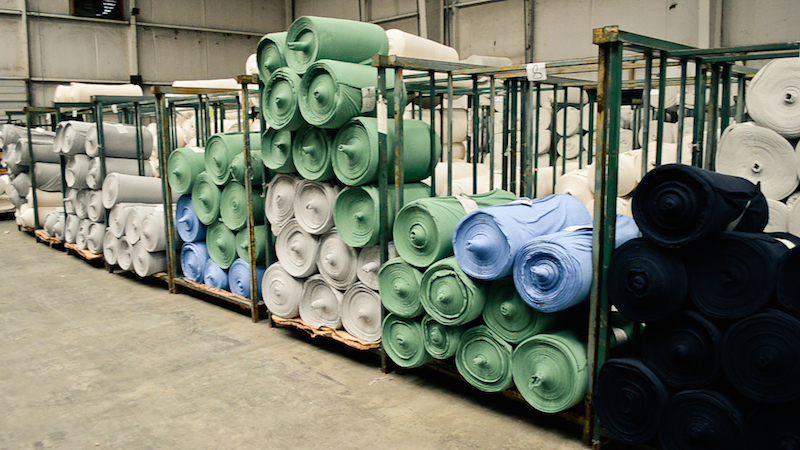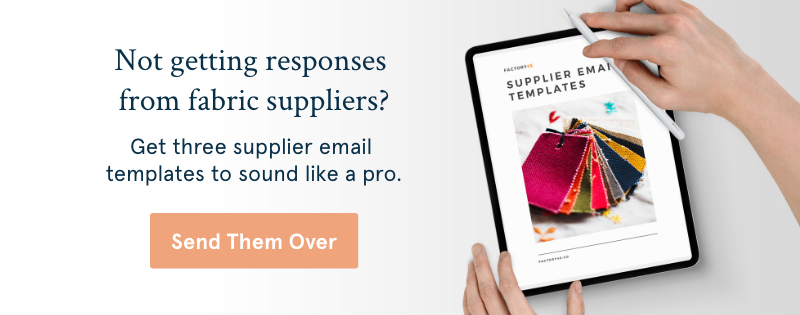4 Mistakes to Avoid When Sourcing Fabric
If you’ve ever tried to source fabric you know it can be, how do I put this…
…an arduous process.
Suppliers don’t answer your emails. They definitely don’t call you back. And sometimes there isn’t even a voicemail to leave a message.
Whether you’ve gone through this or you haven’t started sourcing yet, there are a few things you can do to raise your chances of getting a positive response.
And it starts with avoiding these four big mistakes:
1.) Writing a long inquiry email
I can’t tell you how many people make the mistake of writing a multi-paragraph email that is so long-winded your own mother wouldn’t even read it.
A fabric inquiry is not the time to go into an explanation of your company mission or your core values or your plan to single-handedly change the fashion industry.
The supplier doesn’t care about that stuff!
What does the supplier care about?
Sales.
What does he or she need to make a sale from you?
A very specific one-sentence description of the exact fabric you’re looking for.
What should that sentence include?
The fiber, the fabrication, the weight and the color.
The end.
(Yes, you can include a “hello” and “thank you.”)
2.) Immediately asking a sales rep for MOQ’s and pricing
MOQ stands for “minimum order quantity.” In other words, the amount of one type of fabric that you’re expected to order to meet the supplier’s requirements.
Of course you need to know if the MOQ is attainable for you (20,000 yards would be a bit ambitious when you’re first starting out…) And of course you need to know how much a yard of fabric costs so you can factor it into your Cost of Goods Sold.
But don’t ask.
When it comes to sourcing fabric, a significant part of the process is getting swatches in the door so you can feel them, put them in the wash, and compare them to one another.
The sales rep wants you to see the value and quality in the fabric just as a car dealer would want you to test drive the car before talking about price.
Let the rep offer the information or wait to ask until you have received the swatches.
There’s nothing worse than appearing overly price-conscious and frugal when you’re already looking for low minimums.
3.) Not building a relationship with the sales rep
You can’t even imagine the awesome things a supplier or sales rep will do for you if you take the time to build a relationship.
Most days a sales rep is dealing with huge amounts of pressure. A big client needs a rush order. A new client received a bad roll. Throw in a handful of inquiry calls from newbies who don’t know what “fabric weight” is and the sales rep is tackling a pretty high-maintenance day.
If you respect their time by knowing exactly what you’re looking for, and you make it easy for them to help you then you’ll see a return.
Building a relationship can happen gradually over the course of a few emails here, a few phone calls there, but if you’re explicit about what you need you never know when a sales rep will call you up out of the blue and say, “We’ve got 300 yards of excess that just came in and we’ll sell it to you at a discount.”
4.) Not being persistent
Fabric sourcing is not for the faint of heart — especially when you’re looking for sustainable and low-impact fabrics.
The mainstream supplier will try to talk you out of sourcing organic cotton or wonder why you’re trying to source Tencel when rayon is so much cheaper.
Stay true to your values and the reasons you have for wanting to create a sustainably-sourced garment. Don’t try to convince them of all the reasons why sustainability is important for the future of fashion.
Keep looking, keep persisting and don’t give up until you get what you’re looking for. It may not happen immediately, but at some point, you’re going to find it.





